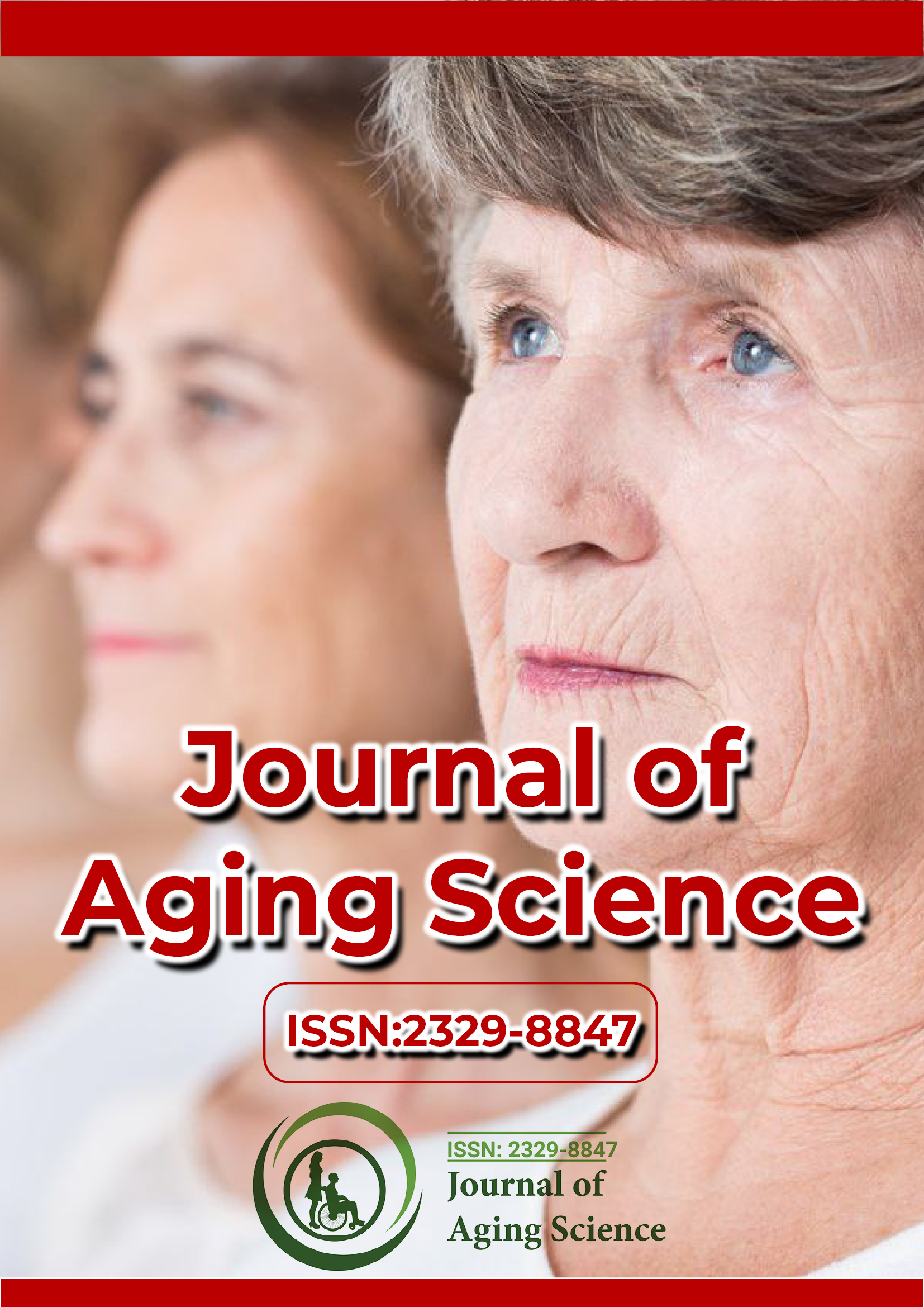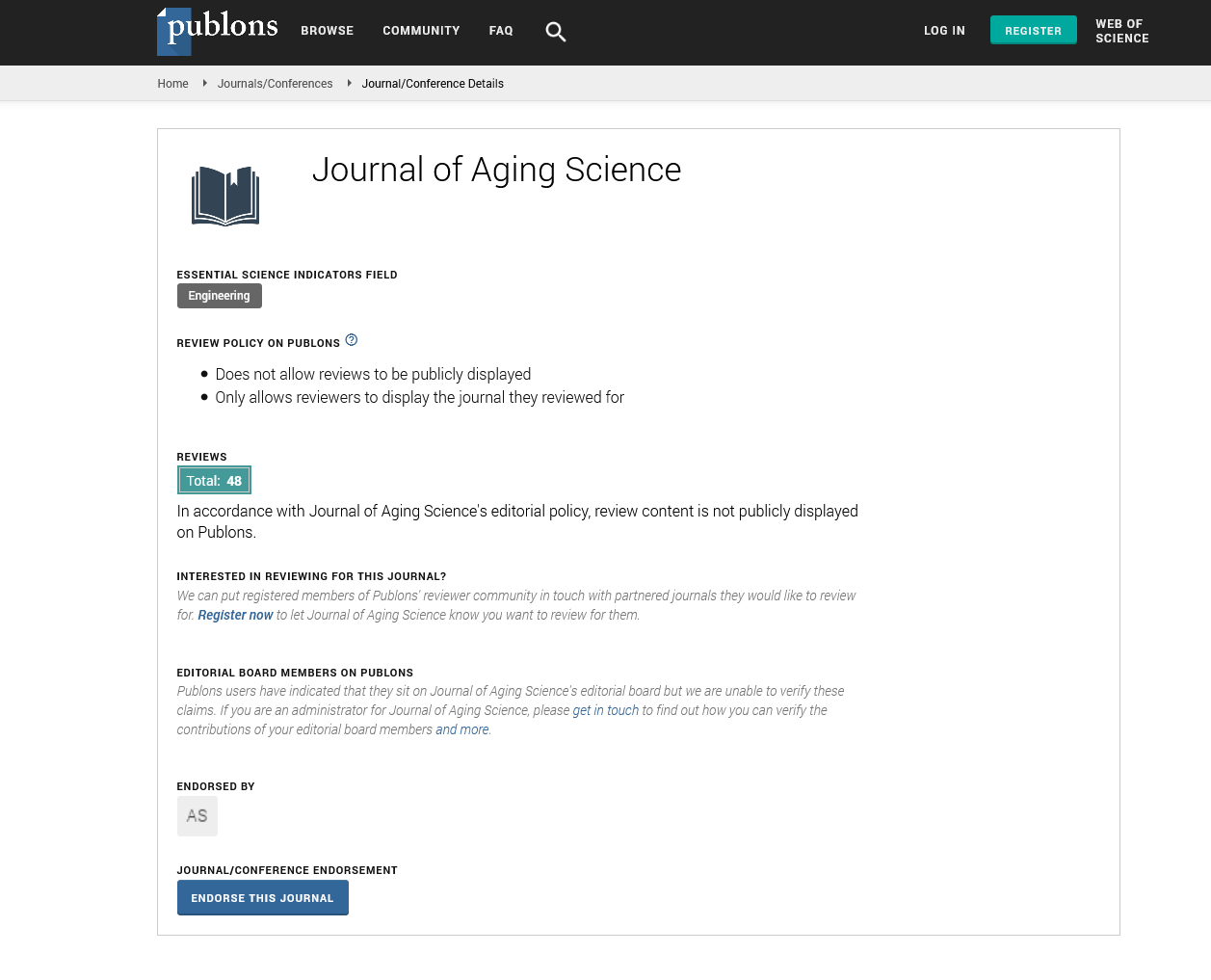Indexed In
- Open J Gate
- Academic Keys
- JournalTOCs
- ResearchBible
- RefSeek
- Hamdard University
- EBSCO A-Z
- OCLC- WorldCat
- Publons
- Geneva Foundation for Medical Education and Research
- Euro Pub
- Google Scholar
Useful Links
Share This Page
Journal Flyer

Open Access Journals
- Agri and Aquaculture
- Biochemistry
- Bioinformatics & Systems Biology
- Business & Management
- Chemistry
- Clinical Sciences
- Engineering
- Food & Nutrition
- General Science
- Genetics & Molecular Biology
- Immunology & Microbiology
- Medical Sciences
- Neuroscience & Psychology
- Nursing & Health Care
- Pharmaceutical Sciences
Opinion Article - (2025) Volume 13, Issue 1
Depression and Anxiety in the Elderly: Neurobiological and Social Factors
Sayaka Otsuka*Received: 27-Feb-2025, Manuscript No. JASC-25-28440; Editor assigned: 01-Mar-2025, Pre QC No. JASC-25-28440 (PQ); Reviewed: 07-Mar-2025, QC No. JASC-25-28440; Revised: 14-Mar-2025, Manuscript No. JASC-25-28440 (R); Published: 28-Mar-2025, DOI: 10.35248/2329-8847.25.13.396
Description
Depression and anxiety are among the most prevalent mental health issues affecting the elderly population. These conditions significantly impact the quality of life, increase physical health problems and contribute to increased mortality. While depression and anxiety can occur at any stage of life, they present unique challenges in the elderly due to a combination of neurobiological changes and social factors. Understanding these underlying mechanisms is important for effective prevention, diagnosis and treatment.
Neurobiological factors
Aging is accompanied by complex changes in brain structure and function, many of which contribute to mood disorders such as depression and anxiety. Several neurobiological mechanisms are implicated in the onset and progression of these conditions in older adults.
Neurotransmitter dysregulation: Neurotransmitter systems undergo significant changes with aging, affecting mood regulation. Dopamine, serotonin and norepinephrine are critical in maintaining emotional balance and their decline has been linked to late-life depression and anxiety. Reduced serotonin levels are particularly associated with increased vulnerability to depressive episodes, while norepinephrine depletion is linked to cognitive deficits and low energy levels. Dopaminergic dysfunction can contribute to anhedonia, a common symptom of depression where individuals lose interest or pleasure in previously enjoyed activities.
Brain structure and functional changes: Structural alterations in the brain, particularly in areas associated with mood regulation, such as the prefrontal cortex, hippocampus and amygdala, are common in aging. Studies using neuroimaging techniques have shown that elderly individuals with depression often exhibit reduced hippocampal volume, which is also linked to cognitive decline. Additionally, disruptions in connectivity between the prefrontal cortex and limbic system can impair emotional regulation and increase susceptibility to anxiety.
Inflammation and the immune system: Chronic low-grade inflammation, often termed "inflammaging," is increasingly recognized as a contributing factor in geriatric depression and anxiety. Elevated levels of pro-inflammatory cytokines such as Interleukin-6 (IL-6) and Tumor Necrosis Factor-Alpha (TNF-α) have been found in elderly individuals with depression. These inflammatory markers can alter neurotransmitter metabolism, reduce neurogenesis and increase oxidative stress, further exacerbating mood disorders.
Hypothalamic-Pituitary-Adrenal (HPA) axis dysfunction: The HPA axis, which controls the body’s stress response, tends to become dysregulated with age, leading to prolonged exposure to cortisol. Elevated cortisol levels have been linked to neuronal damage, particularly in the hippocampus and contribute to the development of anxiety and depression. This dysregulation may also increase existing cognitive decline and increase the risk of dementia.
Social factors
Beyond neurobiological changes, social factors play a significant role in the development and persistence of depression and anxiety in the elderly. Socioeconomic conditions, life transitions and interpersonal relationships influence mental health outcomes.
Social isolation and loneliness: Social isolation and loneliness are among the most significant risk factors for depression and anxiety in older adults. The loss of a spouse, retirement and physical limitations can contribute to reduced social interactions, leading to feelings of loneliness and helplessness. Studies have shown that socially isolated individuals have higher levels of cortisol and inflammatory markers, which may increase mood disorders.
Loss and bereavement: The experience of grief due to the loss of loved ones is a common stressor in later life. The death of a spouse, friends, or close relatives can trigger prolonged sadness, hopelessness and anxiety. Bereavement-related depression, if not managed properly, can lead to severe mental health conditions, including suicidal ideation.
Financial stress and economic instability: Economic insecurity can significantly impact mental health in older adults. Many elderly individuals live on fixed incomes or rely on pensions, which may not be sufficient to cover medical expenses, housing, or daily needs. Financial stress can lead to chronic anxiety and increase depressive symptoms.
Stigma and mental health awareness: Many older adults grew up in a time when mental health issues were stigmatized, leading to reluctance in seeking professional help. The lack of awareness and cultural barriers can prevent timely diagnosis and treatment, allowing symptoms to worsen over time.
Management and treatment approaches
Given the multifaceted nature of depression and anxiety in the elderly, an integrated approach combining medical, psychological and social interventions is necessary.
Pharmacological treatments: Selective Serotonin Reuptake Inhibitors (SSRIs) and Serotonin-Norepinephrine Reuptake Inhibitors (SNRIs) are commonly prescribed for elderly individuals with depression and anxiety. However, medication responses vary due to age-related metabolic changes, necessitating careful monitoring for side effects.
Psychotherapy and counseling: Cognitive-Behavioral Therapy (CBT) and Interpersonal Therapy (IPT) have proven effective in treating depression and anxiety in older adults. These therapies help individuals develop coping strategies, address negative thought patterns and improve social interactions.
Social support and community engagement: Encouraging social interactions through community programs, support groups and volunteer activities can help alleviate loneliness and encourage a sense of purpose. Family involvement and caregiver support also plays important roles in improving mental wellbeing.
Conclusion
Depression and anxiety in the elderly are complex conditions influenced by both neurobiological and social factors. As the aging population continues to grow, understanding these mechanisms is critical for developing effective interventions. By addressing neurotransmitter imbalances, reducing inflammation, encouraging social connections and promoting mental health awareness, we can enhance the quality of life for older adults and ensure healthier aging.
Citation: Otsuka S (2025). Depression and Anxiety in the Elderly: Neurobiological and Social Factors. J Aging Sci. 12:396.
Copyright: © 2025 Otsuka S. This is an open-access article distributed under the terms of the Creative Commons Attribution License, which permits unrestricted use, distribution and reproduction in any medium, provided the original author and source are credited.

